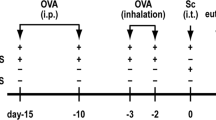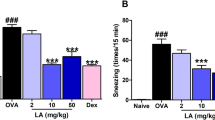Abstract
Asthma is one of the most common chronic airway inflammatory diseases. The clinical hallmarks of asthma include elevated serum levels of immunoglobulin E (IgE), eosinophilic inflammation and airway hyper-responsiveness (AHR). Arsenic trioxide (As2O3) is considered a carcinogen; however, it has also been used to treat diseases, such as syphilis, in traditional Chinese and Western medicine. Today, As2O3 is used as one of the standard therapies for acute promyelocytic leukemia (APL). Previous studies have indicated that As2O3 can induce apoptosis in eosinophils. However, the effect of As2O3 on asthma has not been investigated. We used ovalbumin (OVA)-immunized mice as a model for asthma and treated mice with As2O3 at doses of 2.5 and 5 mg/kg. The mice were then monitored for OVA-specific IgE production, airway inflammatory cell infiltration and AHR. We found that administration of As2O3 in OVA-immunized mice abrogated airway eosinophil recruitment by downregulating eotaxin expression but did not alter serum IgE or IL-5 levels in bronchoalveolar lavage fluid (BALF). Furthermore, the development of AHR and cellular infiltration into the airway were reduced by treating mice with As2O3. In vitro data suggested that low concentrations of As2O3 could induce only a small degree of apoptosis in primary pulmonary cells but could significantly inhibit the secretion of eotaxin by these cells. These results indicate that the administration of As2O3 to OVA-immunized mice can suppress lung allergic inflammatory responses. As2O3 might therefore have therapeutic potential in treating allergic airway inflammatory diseases.
This is a preview of subscription content, access via your institution
Access options
Subscribe to this journal
Receive 12 digital issues and online access to articles
$119.00 per year
only $9.92 per issue
Buy this article
- Purchase on Springer Link
- Instant access to full article PDF
Prices may be subject to local taxes which are calculated during checkout






Similar content being viewed by others
References
Arm JP, Lee TH . The pathobiology of bronchial asthma. Adv Immunol 1992; 51: 323–382.
Azzawi M, Bradley B, Jeffery PK, Frew AJ, Wardlaw AJ, Knowles G et al. Identification of activated T lymphocytes and eosinophils in bronchial biopsies in stable atopic asthma. Am Rev Respir Dis 1990; 142: 1407–1413.
Robinson DR, Hamid Q, Ying S, Tsicopoulos A, Barkans J, Bentley AM . Predominant Th2-like bronchoalveolar T-lymphocyte population in atopic asthma. N Engl J Med 1992; 326: 298–304.
Nielsen FH, Uthus EO . Arsenic. In: Frieden F (ed.) Biochemistry of the Essential Ultratrace Elements. New York: Plenum, 1981: 319.
Bishop C, Kipling MD . Arsenic and cancer. J Soc Occup Med 978 28: 3–5.
Lerda D . Sister-chromatic exchange (SCE) among individuals chronically exposed to arsenic in drinking water. Mutat Res 1994; 312: 111.
Chen ZY, Liu TP, Yang Y (eds). Manual of Clinical Drugs. Shanghai: Shanghai Science and Technology Press, 1995: 830.
Dilda PJ, Hogg PJ . Arsenical-based cancer drugs. Cancer Treat Rev 2007; 33: 542–564.
Perdrup A . Penicillin versus arsenical-bismuth treatment in early syphilis. Acta Derm Venereol Suppl (Stockh) 1950; 31 (Suppl. 24): 44–48.
Zhou LF, Yin KS . Effect of arsenic trioxide on apoptosis of pulmonary eosinophils in asthmatic guinea-pigs. Zhongguo Zhong Xi Yi Jie He Za Zhi 2002; 22: 292–294.
Chuang YH, Fu CL, Lo YC, Chiang BL . Adenovirus expressing Fas ligand gene decreases airway hyperresponsiveness and eosinophilia in a murine model of asthma. Gene Ther 2004; 11: 1497–1505.
Hamelmann E, Schwarze J, Takeda K, Oshiba A, Larsen GL, Irvin CG et al. Non-invasive measurement of airway responsiveness in allergic mice using barometric plethysmography. Am J Respir Crit Care Med 1997; 156: 766–775.
Lee YL, Fu CL, Ye YL, Chiang BL . Administration of interleukin-12 prevents mite Der p1 allergen-IgE antibody production and airway eosinophil infiltration in an animal model of airway inflammation. Scand J Immunol 1999; 49: 229–236.
Ye YL, Huang WC, Lee YL, Chiang BL . Interleukin-12 inhibits eotaxin secretion of cultured primary lung cells and alleviates airway inflammation in vivo. Cytokine 2002; 19: 76–84.
Kay AB . The role of eosinophils in the pathogenesis of asthma. Trends Mol Med 2005; 11: 148–152.
Chen GQ . Use of arsenic trioxide in the treatment of acute promyelocytic leukemia (APL): I. arsenic trioxide exerts dose-dependent dual effects on APL cells. Blood 1997; 89: 3345–3353.
Shao W . Arsenic trioxide as an inducer of apoptosis and loss of PML/RAR alpha protein in acute promyelocytic leukemia cells. J Natl Cancer Inst 1998; 90: 124–133.
Soigner SL . Complete remission after treatment of acute promyelocytic leukemia with arsenic trioxide. N Eng J Med 1998; 339: 1341–1348.
Trouba KJ, Germolec DR . Micromolar concentrations of sodium arsenite induce cyclooxygenase-2 expression and stimulate p42/44 mitogen-activated protein kinase phosphorylation in normal human epidermal keratinocytes. Toxicol Sci 2004; 9: 248–257.
MacLean JA, Wenbey R, Luster AD . T cell-dependent regulation of eotaxin in antigen-induced pulmonary eosinophilia. J Exp Med 1996; 184: 1461–1469.
Itami DM, Latinne D, Bazin H, Garcia ML, Perini A, Martins MA et al. Immunoglobin E is not required for but enhances airway inflammation and hyperresponsiveness. Allergy 2003; 58: 1117–1124.
Ying S, Robinson DS, Meng Q, Rottman J, Kennedy R, Ringler DJ et al. Enhanced expression of eotaxin and CCR3 mRNA and protein in atopic asthma. Association with airway hyperresponsiveness and predominant colocalization of eotaxin mRNA to bronchial epithelial and endothelial cells. Eur J Immunol 1997; 27: 3507–3516.
Rothenberg ME . Eosinophilia. N Eng J Med 1998; 338: 1592–1600.
Palframan RT, Collins PD, Williams TJ, Rankin SM . Eotaxin induces a rapid release of eosinophils and their progenitors from the bone marrow. Blood 1998; 91: 2240–2248.
Humbles AA, Conroy DM, Marleau S, Rankin SM, Palframan RT, Proudfoot AE et al. Kinetics of eotaxin generation and its relationship to eosinophil accumulation in allergic airways disease: analysis in a guinea pig model in vivo. J Exp Med 1997; 186: 601–612.
Jose PT, Griffiths-Johnson DA, Collins PD, Walsh DT, Moqbel R, Totty NF et al. Eotaxin: a potent eosinophil chemoattractant cytokine detected in a guinea pig model of allergic airways inflammation. J Exp Med 1994; 179: 881–887.
Lamkhioued B, Renzi PM, Younes A, Garcia-Zepeda EA, Allakhverdi Z, Ghaffar O et al. Increased expression of eotaxin in bronchoalveolar lavage and airways of asthmatics contributes to the chemotaxis of eosinophils to the site of inflammation. J Immunol 1997; 159: 4593–4601.
Martin TR, Takeishi T, Katz HR, Austen KF, Drazen JM, Galli SJ . Mast cell activation enhances airway responsiveness to methacholine in the mouse. J Clin Invest 1993; 91: 1176–1182.
Zhou LF, Zhu Y, Cui XF, Xie WP, Hu AH, Yin KS . Arsenic trioxide, a potent inhibitor of NF-κB, abrogates allergen-induced airway hyperresponsiveness and inflammation. Resperatory Res 2006; 7: 146–158.
Author information
Authors and Affiliations
Corresponding author
Rights and permissions
About this article
Cite this article
Chu, KH., Lee, CC., Hsin, SC. et al. Arsenic trioxide alleviates airway hyperresponsiveness and eosinophilia in a murine model of asthma. Cell Mol Immunol 7, 375–380 (2010). https://doi.org/10.1038/cmi.2010.26
Received:
Revised:
Accepted:
Published:
Issue Date:
DOI: https://doi.org/10.1038/cmi.2010.26
Keywords
This article is cited by
-
Paradoxical effects of arsenic in the lungs
Environmental Health and Preventive Medicine (2021)
-
Arsenic trioxide ameliorates experimental autoimmune encephalomyelitis in C57BL/6 mice by inducing CD4+ T cell apoptosis
Journal of Neuroinflammation (2020)
-
Double-Sided Personality: Effects of Arsenic Trioxide on Inflammation
Inflammation (2018)
-
Modification of association between prior lung disease and lung cancer by inhaled arsenic: A prospective occupational-based cohort study in Yunnan, China
Journal of Exposure Science & Environmental Epidemiology (2016)
-
Arsenic trioxide alleviates airway hyperresponsiveness and promotes apoptosis of CD4+ T lymphocytes: evidence for involvement of the ER stress–CHOP pathway
Irish Journal of Medical Science (2013)



